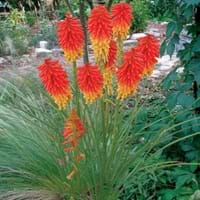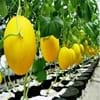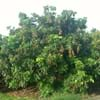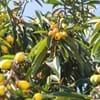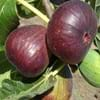Life Span
Annual or Biennial
Perennial
Origin
Africa
Hybrid origin
Types
Earlibrew, Honey King, Moonshine, Brilliance,Honey Chow
Not Available
Number of Varieties
Not Available
Habitat
Semi arid regions
Damp Places, Marshy ground
USDA Hardiness Zone
Not Available
6-9
Sunset Zone
2a, 2b, 3a, 3b, 4, 5, 6, 7, 8, 9, 10, 11, 12, 13, 14, 15, 16, 17, 18, 19, 20, 21, 22, 23, 24
2a, 2b, 3a, 3b, 4, 5, 6, 7, 8, 9, 14, 15, 16, 17, 18, 19, 20, 21, 22, 23, 24
Habit
Vining/Climbing
Clump-Forming
Flower Color
Yellow
Yellow, Red, Orange, Pink
Flower Color Modifier
Bicolor
Bicolor
Fruit Color
White, Yellow, Salmon
Not Available
Leaf Color in Spring
Green
Green, Blue Green
Leaf Color in Summer
Dark Green
Green, Blue Green
Leaf Color in Fall
Dark Green
Blue Green, Gray Green, Light Yellow
Leaf Color in Winter
Light Green
Light Green
Leaf Shape
Heart-shaped
Linear
Plant Season
Summer, Fall
Spring, Summer
Sunlight
Full Sun
Full Sun, Partial Sun
Type of Soil
Loam
Clay, Loam, Sand
The pH of Soil
Neutral
Acidic, Neutral
Soil Drainage
Well drained
Well drained
Bloom Time
Indeterminate
Early Summer, Summer
Tolerances
Drought
Drought
Where to Plant?
Container, Ground
Container, Ground
How to Plant?
Seedlings
Divison, Seedlings
Plant Maintenance
Medium
Medium
Watering Requirements
Reduce watering once fruit are growing, Requires a lot of watering, Requires consistently moist soil
Needs more water during establishment, Water Deeply, Water in morning to avoid prompting diseases, Water in the early morning hours
In Summer
Lots of watering
Lots of watering
In Spring
Moderate
Moderate
In Winter
Average Water
Average Water
Soil pH
Neutral
Acidic, Neutral
Soil Type
Loam
Clay, Loam, Sand
Soil Drainage Capacity
Well drained
Well drained
Sun Exposure
Full Sun
Full Sun, Partial Sun
Pruning
Remove damaged leaves, Remove dead branches, Remove dead leaves
Cut or pinch the stems, Remove damaged leaves, Remove dead branches, Remove dead leaves
Fertilizers
All-Purpose Liquid Fertilizer
All-Purpose Liquid Fertilizer, Apply N-P-K
Pests and Diseases
Anthracnose, Aphids, Bacterial fruit blotch, Cucumber beetles, Downy mildew, Southern Bacterial Wilt, Spider mites
Onion thrips, Red blotch, Root rot
Plant Tolerance
Drought
Drought, Moisture
Flower Petal Number
Single
Single
Foliage Texture
Coarse
Coarse
Foliage Sheen
Matte
Matte
Attracts
Not Available
Snails
Allergy
breathing problems, Cough, cramps, Diarrhea, Itchy eyes, Mouth itching, Nasal Congestion, Throat itching, wheezing
Not Available
Aesthetic Uses
Not Used For Aesthetic Purpose
Borders, Cottage Garden, Ground Cover
Beauty Benefits
Not Available
Not Available
Environmental Uses
Air purification
Air purification
Medicinal Uses
Potassium, Vitamin C
Not Available
Part of Plant Used
Fruits, Leaves, Root, Seeds
Not Available
Other Uses
Added to salads, Used in tea, wine and sweet dishes, Used to flavour soups
Not Available
Used As Indoor Plant
No
No
Used As Outdoor Plant
Yes
Yes
Garden Design
Edible, Fruit / Fruit Tree, Herb / Vegetable, Vine
Container, Cutflower, Mixed Border, Rock Garden, Wall
Botanical Name
CUCUMIS melo 'Honey I Dew'
KNIPHOFIA 'Border Ballet'
Common Name
Honey I Dew Honeydew, Honeydew
Tritoma, Wisley Blue Spring Starflower, Wisley Blue Springstar
In Hindi
खरबूज़ा [kharabooza]
Tritoma
In German
Honigtau
Tritoma
In French
Miellat
Tritoma
In Spanish
Gotas de miel
tritoma
In Greek
πεπόνι μελιτώματος [pepóni melitómatos]
tritoma
In Portuguese
melão de Honeydew
Tritoma
In Polish
melon spadzi
Tritoma
In Latin
honeydew
Trytoma
Phylum
Magnoliophyta
Tracheophyta
Class
Magnoliopsida
Magnoliopsida
Order
Cucurbitales
Asparagales
Family
Cucurbitaceae
Liliaceae
Clade
Not Available
Angiosperms, Monocots
Tribe
Not Available
Not Available
Subfamily
Not Available
Not Available
Number of Species
Not Available
Properties of Honeydew and Tritoma
Wondering what are the properties of Honeydew and Tritoma? We provide you with everything About Honeydew and Tritoma. Honeydew doesn't have thorns and Tritoma doesn't have thorns. Also Honeydew does not have fragrant flowers. Honeydew has allergic reactions like breathing problems, Cough, cramps, Diarrhea, Itchy eyes, Mouth itching, Nasal Congestion, Throat itching and wheezing and Tritoma has allergic reactions like breathing problems, Cough, cramps, Diarrhea, Itchy eyes, Mouth itching, Nasal Congestion, Throat itching and wheezing. Compare all the properties and characteristics of these two plants. Find out which of these plant can be used as indoor plant. If you are interested to decorate your house and garden, find out aesthetic uses, compare them and select the plant which will beautify your surrounding. Along with beautification, try comparing medicinal and edible uses of Honeydew and Tritoma and you can choose the plant having best and most benefits.
Season and Care of Honeydew and Tritoma
Season and care of Honeydew and Tritoma is important to know. While considering everything about Honeydew and Tritoma Care, growing season is an essential factor. Honeydew season is Summer and Fall and Tritoma season is Summer and Fall. The type of soil for Honeydew is Loam and for Tritoma is Clay, Loam, Sand while the PH of soil for Honeydew is Neutral and for Tritoma is Acidic, Neutral.
Honeydew and Tritoma Physical Information
Honeydew and Tritoma physical information is very important for comparison. Honeydew height is 20.30 cm and width 150.00 cm whereas Tritoma height is 45.70 cm and width 50.80 cm. The color specification of Honeydew and Tritoma are as follows:
Honeydew flower color: Yellow
Honeydew leaf color: Green
Tritoma flower color: Yellow, Red, Orange and Pink
- Tritoma leaf color: Green and Blue Green
Care of Honeydew and Tritoma
Care of Honeydew and Tritoma include pruning, fertilizers, watering etc. Honeydew pruning is done Remove damaged leaves, Remove dead branches and Remove dead leaves and Tritoma pruning is done Cut or pinch the stems, Remove damaged leaves, Remove dead branches and Remove dead leaves. In summer Honeydew needs Lots of watering and in winter, it needs Average Water. Whereas, in summer Tritoma needs Lots of watering and in winter, it needs Average Water.

